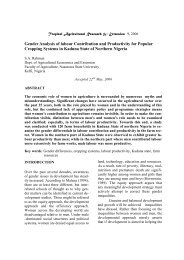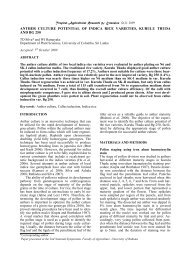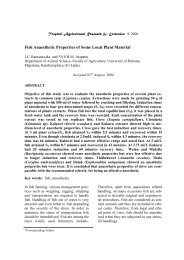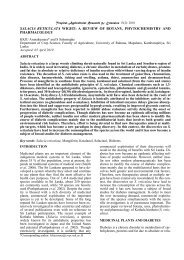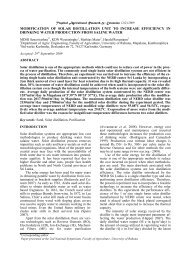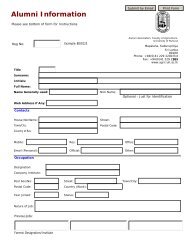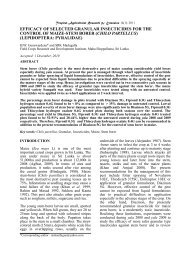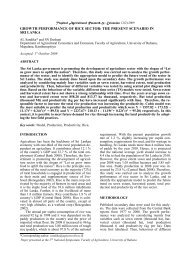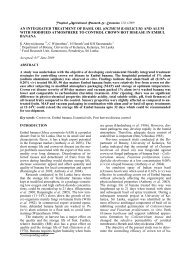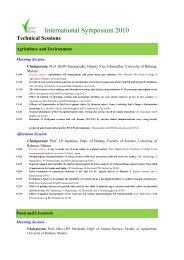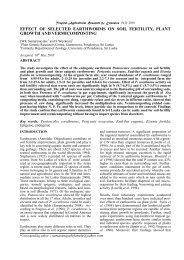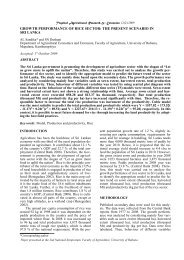Print this article - Sri Lanka Journals Online
Print this article - Sri Lanka Journals Online
Print this article - Sri Lanka Journals Online
You also want an ePaper? Increase the reach of your titles
YUMPU automatically turns print PDFs into web optimized ePapers that Google loves.
Tropical Agricultural Research & Extension 11, 2008<br />
MICROPROPAGATION OF TWO ENDEMIC THREATENED CRYPTOCORYNE SPECIES OF<br />
SRI LANKA<br />
HMI Herath * , SA Krishnarajah and DSA Wijesundara<br />
National Botanic Gardens, Peradeniya, <strong>Sri</strong> <strong>Lanka</strong><br />
Accepted: 4 th September 2008<br />
ABSTRACT<br />
An efficient protocol was developed for the micropropagation of Cryptocoryne beckettii and Cryptocoryne<br />
bogneri, two endemic threatened aquatic herbs of <strong>Sri</strong> <strong>Lanka</strong>, highly valued as aquarium plants.<br />
Rhizomes of C. beckettii and C. bogneri were established on full strength Murashige and Skoog (MS)<br />
medium with 3% sucrose and regenerated shoots were cultured on MS medium supplemented with<br />
combinations of 6-benzylaminopurine (BAP) 2, 5, 8, 10 mg l -1 and 0.1 mg l -1 indole acetic acid (IAA) for<br />
multiple shoot regeneration. For root induction and shoot growth, agar solidified full and half strength<br />
MS medium and a soil-based medium were used. The presence of growth regulators in MS medium had<br />
a significantly high (p
20<br />
In vitro propagation is a most efficient and cost<br />
effective method of propagating large number of<br />
clonal offspring. According to Alistock and<br />
Shafer (2006), the plants produced by in vitro<br />
propagation are genetically uniform, vigorous and<br />
free from associations with other organisms an attribute<br />
particularly useful for the culture of under<br />
water grasses where contaminating organisms can<br />
dominate other types of production systems. Many<br />
tissue cultured water plant species show a more<br />
bushy growth with more adventitious shoots, qualities<br />
that many aquarists appreciate (Christensen,<br />
1996).<br />
Agar is used as the gelling agent and it is one of<br />
the most expensive components in the culture media<br />
(Tyagi et al., 2007). Of medium components<br />
the gelling agents such as agar contributes 70% of<br />
the costs. Proper choice of media can reduce the<br />
cost of micropropagation (Prakash et al., 2004).<br />
Low cost tissue culture technology will stay a<br />
higher priority in agriculture, horticulture, floriculture<br />
of many developing countries for the production<br />
of suitably priced high quality planting material<br />
(Savangikar, 2004).<br />
This experiment was conducted to develop an<br />
efficient in vitro propagation procedure for the micropropagation<br />
of both Cryptocoryne bogneri and<br />
Cryptocoryne beckettii. This study the objectives<br />
were to investigate the effect of (1) different<br />
growth regulators (2) type of culture media and (3)<br />
nutrient concentration of the media for the micropropagation<br />
of species to get adequate quantity of<br />
plantlets with good quality, especially with well<br />
developed root system. In <strong>this</strong> experiment we also<br />
wanted to develop a new low cost medium for large<br />
scale plant production.<br />
Table 1: Effect of BAP (mg l- 1 ) and IAA (mg l- 1 ) during<br />
in vitro shoot multiplication of C.beckettii and<br />
C. bogneri two months after the culture establishment<br />
Code<br />
T1<br />
T2<br />
T3<br />
T4<br />
T5<br />
T6<br />
T7<br />
T8<br />
T9<br />
T10<br />
Treatment<br />
BAP<br />
(mg l -1 )<br />
0<br />
2.0<br />
5.0<br />
8.0<br />
10.0<br />
0<br />
2.0<br />
5.0<br />
8.0<br />
10.0<br />
IAA<br />
(mg l -1 )<br />
0<br />
0<br />
0<br />
0<br />
0<br />
0.1<br />
0.1<br />
0.1<br />
0.1<br />
0.1<br />
HMI HERATH:MICROPROPAGATION OF CRYPTOCORYNE<br />
Mean number of shoots + s.e<br />
C.beckettii<br />
10.4 e + 3.88<br />
13.6 de + 4.90<br />
11.6 e + 1.68<br />
16.0 d + 3.11<br />
16.8 d + 5.55<br />
23.6 c + 1.53<br />
30.4 b + 1.95<br />
43.0 a + 2.36<br />
29.6 b + 1.57<br />
30.0 b + 2.74<br />
C. bogneri<br />
4.2 g + 0.31<br />
12.0 ef + 2.14<br />
12.2 ef + 2.32<br />
11.4 f + 1.56<br />
13.4 e + 2.41<br />
19.2 d + 1.31<br />
38.8 b + 4.33<br />
51.8 a + 5.41<br />
50.4 a + 3.56<br />
27.4 c + 3.72<br />
(T1 = without hormones; T2 – T5 = 2.0 -10.0 mg l-1 BAP<br />
alone ; T6 = 0.1 mg l-1 IAA alone; T7 – T10 ; 2.0 – 10.0 mg l-<br />
1 BAP in combination with 0.1 mg l-1 IAA)<br />
MATERIALS AND METHODS<br />
Materials and disinfection<br />
Rhizomes were collected from healthy growing<br />
mother plants of C.beckettii and C. bogneri in the<br />
fresh water ponds of the Royal Botanic Gardens,<br />
Peradeniya, <strong>Sri</strong> <strong>Lanka</strong>. These rhizomes were<br />
washed well with soap and water and rinsed under<br />
running tap water for six hours. Next they were<br />
dipped in a 3% (v/v ) ‘thiophanate methyl 70%’<br />
solution (fungicide) overnight. The rhizomes were<br />
washed again under running tap water for one hour,<br />
disinfected in 70% (v/v) ethanol for one minute and<br />
20% (v/v) sodium hypochlorite solution for 15<br />
minutes. The materials were rinsed well with sterilized<br />
distilled water five times before culture.<br />
Culture establishment<br />
The rhizomes were cut into 1 cm length fragments<br />
and five explants were placed horizontally on full<br />
strength Murashige and Skoog (1962) medium with<br />
3% sucrose in flasks with 40 ml medium per flask.<br />
Fifty culture flasks were established and they were<br />
kept under white fluorescent light (30 µE m -2 s -1 )<br />
with 16 hour photoperiod for shoot regeneration.<br />
Shoot multiplication<br />
To develop a suitable medium for shoot multiplication,<br />
MS medium was supplemented with 2, 5, 8,<br />
10 mg l -1 6 benzylaminopurine (BAP) with or without<br />
0.1 mg l -1 indole acetic acid (IAA). Murashige<br />
and Skoog medium without growth regulators was<br />
used as the control (Table 1). After six weeks, the<br />
shoots regenerated from rhizome explants were<br />
excised and three regenerated shoots were cultured<br />
in each replicate culture bottle. Culture bottle with<br />
40 ml medium was considered as a replicate and<br />
there were five replicates per each treatment. The<br />
experiment was repeated twice. After two months<br />
of culture the number of shoots regenerated from<br />
each shoot explant was counted.<br />
Root induction and shoot growth<br />
For the selection of a suitable media for root induction<br />
and further shoot growth, two types of basal<br />
media were tested. Agar solidified full or half<br />
strength MS medium supplemented with 0.1, 0.2<br />
mg l -1 α- naphthaline acetic acid (NAA) or without<br />
hormones and a soil based medium consisting of a<br />
mixture of equal parts of 2 mm size ground brick<br />
fragments: sand: charcoal: top soil (medium A)<br />
saturated with full or half strength liquid MS medium<br />
with 0.1, 0.2 mg l -1 NAA or without hormones<br />
(Table 2). Shoots of 0.5 cm in height were
Figure 1: In vitro propagation of C. beckettii and C.<br />
bogneri. (a) Multiple shoots development in C.<br />
beckettii on MS medium supplemented with 5.0 mg l -1<br />
BAP and 0.1 mg l -1 IAA. (b) C. bogneri plant grown<br />
on soil based medium with equal parts of 2 mm size<br />
ground brick: sand: charcoal: top soil soaked in half<br />
strength MS medium supplemented with 0.1 mg l -1<br />
NAA. (c) C. beckettii plants acclimatized in clay pots<br />
with 2: 1 clay: sand mixture. (d) C. bogneri acclimatized<br />
in clay: sand mixture.<br />
cultured in these media. Each treatment was replicated<br />
five times and each culture bottle had five<br />
shoots. After two months time, the number of roots<br />
induced in each plant, root length and shoot height<br />
were recorded.<br />
Acclimatization<br />
Plantlets that developed root system were planted<br />
in a mixture of two parts sterilized clay: one part<br />
sand (2 mm) in clay pots provided with sterilized<br />
distilled water up to 1 cm height.<br />
Statistical analyses<br />
The experiment was arranged in a Completely Randomized<br />
Design (CRD). Statistical analyses of<br />
data were performed using Statistical Analysis System<br />
(SAS Release 9.1). Data were subjected to<br />
analyses of variance and the mean comparison was<br />
done using Duncan Multiple Range Test (DMRT)<br />
at 5% significance level.<br />
RESULTS<br />
Shoot initiation and multiplication<br />
During culture initiation, rhizomes of C. beckettii<br />
regenerated new shoots in MS medium in the absence<br />
of growth regulators. The presence of growth<br />
regulators (BAP and IAA) in the MS medium sig-<br />
Tropical Agricultural Research & Extension 11, 2008<br />
nificantly (p
22<br />
Root and shoot growth of C. beckettii was significantly<br />
high (p
100% and the plantlets grown in agar solidified<br />
medium were acclimatized with 86% survival rate.<br />
DISCUSSION<br />
The results of <strong>this</strong> study indicates that, the growth<br />
regulator supplementation is essential for the micropropagation<br />
of Cryptocoryne species. Both<br />
species had highest shoot proliferation in the combination<br />
of 5.0 mg l -1 BAP and 0.1 mg -1 IAA. The<br />
effect of growth regulators in shoot multiplication<br />
has been reported for other Cryptocoryne species as<br />
well as other water plant species. According to<br />
Hongrat et al (2005), maximum number of shoots<br />
of Cryptocoryne cordata was regenerated in MS<br />
medium supplemented with BA at 1 mg l -1 . According<br />
to Zhou et al (2006), both MS and NAA<br />
significantly influenced the root number, total root<br />
length of Myriophyllum spicatum L. a submerged<br />
macrophyte. Koch and Durako (2005) have reported<br />
that, NAA addition to the medium has resulted<br />
in increased leaf and internodal lengths of<br />
submerged angiosperm Ruppia maritima. Wang et<br />
al. (2004) reported that, presence of BAP 3 mg l -1<br />
in the medium effectively increased the number of<br />
regenerated shoots of Scirpus robustus an emergent<br />
hydrophyte.<br />
Auxins commonly used in plant tissue culture<br />
media includes IAA and NAA. Auxins are particularly<br />
included in a culture medium to stimulate callus<br />
production and cell growth, to initiate shoots,<br />
particularly roots and to induce somatic embryogenesis.<br />
Cytokinines (BAP) have been reported to<br />
induce the development of axillary buds and adventitious<br />
buds through decreasing apical dominance<br />
(Taji et al., 1995). When cytokinin level was higher<br />
than the auxin level, shoot development was promoted.<br />
In the present investigation too, the presence<br />
of cytokinin at a relatively high level with low<br />
level of auxin promoted the shoot multiplication. In<br />
<strong>this</strong> experiment without hormones the shoot multiplication<br />
and root induction were lowest. High level<br />
of shoot multiplication could observe when both<br />
auxin and cytokinin were present in the medium<br />
and their ratio was low.<br />
Plantlets established in ‘medium A’ had significantly<br />
high shoot and root growth compared to the<br />
agar solidified medium. The charcoal in the<br />
‘medium A’ may have adsorbed inhibitory compounds<br />
in the medium and it may have facilitated<br />
root growth. Eymar et. al (2000) have reported that,<br />
when root morphogenesis of Lagerstroemia indica<br />
was inhibited by addition of BA to the medium it<br />
can be overcome by the activated charcoal. Similarly,<br />
darkness of the ‘medium A’ compared to the<br />
agar solidified medium may have facilitated the<br />
root growth of the plantlets. The composition of<br />
above medium also may have facilitated the root<br />
Tropical Agricultural Research & Extension 11, 2008<br />
penetration. Nutrient and hormone uptake from the<br />
liquid MS added to the ‘medium A’ may have been<br />
easier than the solid medium which may have facilitated<br />
the better shoot and root growth. Cao et al<br />
(2006) have observed the fresh weight and length<br />
of shoots of Wasabia japonica derived from MS<br />
liquid medium were significantly higher then those<br />
derived from MS semi solidified medium.<br />
Seneviratne et al (2004) have reported that, a mixture<br />
of equal parts of sand, charcoal, tile pieces and<br />
coir dust can be successfully used in orchid in<br />
vitro culture provided with liquid Knudson C medium.<br />
Composition of the ‘medium A’ is similar to<br />
the soil medium where the plantlets were acclimatized.<br />
The root system of plantlets grown in <strong>this</strong><br />
medium was also well developed. These reasons<br />
may have resulted in a higher survival. According<br />
to Savangikar (2004), low cost options should<br />
lower the cost of production without compromising<br />
the quality of the plants. The generated plants must<br />
be vigorous and capable of being successfully<br />
transplanted in the field and must have high field<br />
survival. The plants established in soil based medium<br />
had highest root induction and shoot growth<br />
and were more vigorous with high field survival<br />
than plants grown in agar medium.<br />
In conclusion, the present study showed that<br />
highest number of shoots proliferation in both C.<br />
beckettii and C. bogneri was with the presence of<br />
5.0 BAP mg l -1 and 0.1 mg l -1 IAA in a basal MS<br />
medium. This medium could there be recommended<br />
for shoot proliferation of these species.<br />
Root induction and shoot growth were optimal in<br />
half strength MS medium supplemented with 0.1<br />
mg l -1 NAA soaked mixture of equal parts of 2mm<br />
size ground brick: sand: charcoal: top soil. The<br />
results of <strong>this</strong> study establish an efficient low cost<br />
in vitro propagation protocol with use of a soil<br />
based medium for C. beckettii and C. bogneri . Using<br />
<strong>this</strong> protocol, starting with single shoot explant<br />
of C. beckettii produced 43-45 plants while C.<br />
bogneri produced 51-56 plants in four months time.<br />
REFERENCES<br />
23<br />
Alistock S and Shafer D 2006 Applications and limitations<br />
of micropropagation for the production of underwaterGrasses.<br />
http://www.kitchenculturekit.com.<br />
Cited 14 January 2008.<br />
Cao H, Krystyna J and Fraser T 2006 Liquid culture for<br />
efficient micropropagation of Wasabia japonica<br />
(MIQ) matsumura. In vitro Cellular and Developmental<br />
Biology-Plant.42 (6). 548-552.<br />
Christensen C 1996 Tropical aquarium plants Denmark.<br />
Aquaphyte online: University of Florida. http://<br />
www.tropica.dk. Cited 10 January 2008.<br />
Dasanayake MD and Fosberg FR 1987 A Revised Hand<br />
Book to the Flora of Ceylon. Vol. VI. Amerind Publishing.<br />
New Delhi.<br />
Eymar E, Alegre J, Toribio M and Lopez-vela D 2000
24<br />
Effect of activated charcoal and 6-benzyleadenine<br />
on in vitro nitrogen uptake by Lagerstroemia indica.<br />
63 (1), 57-65.<br />
Hongrat R, Tantrwiwat S and Nakoran MN 2005 In vitro<br />
propagation of Cryptocoryne cordata. Proc. 43 rd<br />
Kasetsart University Annual Conference, Thailand.<br />
Koch EW and Durako MJ 2005 In vitro studies of the<br />
submerged angiosperm Ruppia maritima: Auxin and<br />
Cytokinin effects on plant growth and development.<br />
Marine Biology. 110. 1-6.<br />
Murashige TP and Skoog F 1962 A revised medium for<br />
rapid growth and bioassays with tobacco tissue culture.<br />
Physiol. Plant. 15 : 473-497.<br />
Prakash S Hoque MI, Brinks T 2004 Culture Media and<br />
Containers. In: Low Cost Options for Tissue Culture<br />
Technology in Developing Countries. Vienna: International<br />
Atomic Energy Agency. IAEA-TECDOC-<br />
1384. 29-40.<br />
Rajathewa RMAP 1999 List of threatened plants according<br />
to IUCN Red Data Book. http://<br />
www.nationalherbarium.nl/cryptocoryne/gallery/<br />
alb/alb.html. Cited 10 June 2007<br />
Savangikar VK 2004 Role of Low Cost Options in Tissue<br />
culture. In: Low Cost Options for Tissue Culture<br />
Technology in Developing Countries. Vienna: International<br />
Atomic Energy Agency. IAEA-TECDOC-<br />
1384. 11-15.<br />
Seneviratne KACN, Wijesundara DSA Dhanasekera<br />
DMUB, Vitharana WMKGSPK and Palipane<br />
PWUB 2004 Potential of replacing agar with inert<br />
p<strong>article</strong>s for in vitro culture of orchid (Dendrobium<br />
Species). Annals of the <strong>Sri</strong> <strong>Lanka</strong> Department of<br />
Agriculture. 6: 325.<br />
HMI HERATH:MICROPROPAGATION OF CRYPTOCORYNE<br />
Taji AM, Dodd WA and Williams RR 1995 Plant<br />
growth regulators in tissue culture. In: Plant Tissue<br />
Culture Practice: Armidale, Australia. 55-57.<br />
Tyagi R, Agrawal A and Mahalakshmi C 2007 Low cost<br />
media for In vitro conservation of turmeric<br />
(Curcuma longa L.) and genetic stability assessment<br />
using RAPD markers. In Vitro Cell Dev Biol. –<br />
Plant. 43: 51-58.<br />
Wang J, Seliskar DM and Gallagher JL 2004 Plant regeneration<br />
via somatic embryogenesis in the brackish<br />
wetland monocot Scirpus robustus. Aquatic Botany<br />
79. 163-174.<br />
Wijesundara DSA and Shantha Siri IG 2004 Some Selected<br />
Aquatic Ornamental Plants of <strong>Sri</strong> <strong>Lanka</strong>. National<br />
Science Foundation. 95<br />
Xema 2005 Introduction to the Cryptocoryne genus.<br />
http://www.greenchanter.com Cited 20 th November<br />
2007.<br />
Yapabandara YMHB and Ranasinghe P 2006 Tissue<br />
culture for mass production of aquatic plant species.<br />
h t t p : / / w w w . a p c t t . o r g / p u b l i c a t i o n / p d f /<br />
tm_dec_tissue.pdf Cited 1 st December 2007<br />
Zhou C, Shuquing A, Jiang J, Yin D, Wang Z, Fang C,<br />
Sun Z and Quian C 2006 An in vitro propagation<br />
protocol of two submerged macrophytes for lake<br />
revegitation in East China. Aquatic Botany. 85: 44-<br />
52.



